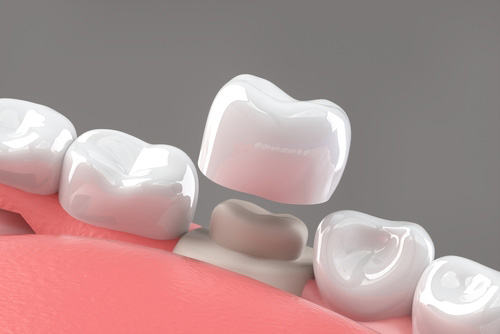Dental Crown Treatment in Turkey Prices, Details and Advantages

- The different types of tooth crowns
- How the crown treatment works
- Durability and maintenance of dental crowns
- The cost of a dental crown in Turkey
- Advantages and disadvantages of Dental Crowns
The human tooth consists of six parts: tooth enamel, tooth crown, dentin, tooth neck, tooth pulp and tooth root. However, only the crown of the tooth is visible, which protrudes from the gums and gives the tooth stability.
If this is severely damaged, dentists replace it with an artificial crown, restoring the original shape of the tooth. The process is called "crowning". An artificial crown is therefore a denture. In the meantime, however, dentistry has become so good that laypeople can usually not tell the difference between real and artificial crowns.
This treatment is usually necessary because of tooth decay . Sugary foods attack the protective covering of the tooth crown - the tooth enamel. Patients often report a throbbing and pulling in the affected tooth. They are sensitive to hot, cold or sweet foods and have white or brown spots on their teeth.
If tooth decay is detected early enough, a filling is usually sufficient to close the hole. If this is no longer possible, the dentist crowns the affected tooth.
Another cause of dental crowns is accidents. For example, if the patient knocks out a tooth in a fall or the natural crown of the tooth is damaged.
There are also aesthetic reasons. Discolored, chipped or worn teeth can be crowned. Dentists can also partially correct misaligned teeth with dental crowns.
In principle, a dentist can crown any tooth. It doesn't matter whether it's anterior, molars or incisors. The only requirements: The dental nerve must not have died and must be firmly anchored in the jawbone. Furthermore, the gums must be healthy as well as the tip of the root.
Also important:The entire tooth does not always have to be crowned. Depending on the clinical picture, a partial crown is also possible. Patients can find out from their dentist which variant is the right one and whether a crown is the right remedy. In any case, they should be thoroughly examined by him before treatment.
The different types of tooth crowns
There are many different types of dental crowns. Basically, experts distinguish between a full and a partial crown. A full crown completely covers the tooth, whereas a partial crown only partially covers the tooth.In addition, dentists differentiate between the crowns according to the material, color, type of manufacture, size and anchoring in the tooth. The following overview lists the most common types of crowns.

Telescopic crown
A telescopic crown consists of an inner and an outer telescope. The dentist inserts the two telescopes into one another and attaches the crown to the patient's tooth using a telescopic prosthesis.Dentists also call this type of crown a double crown. Telescopic crowns are made of metal and can be veneered with ceramic so that they are indistinguishable from the rest of your teeth. Dentists use them when the patient wants to remove the denture if necessary, but still want it to be firmly anchored to the rest of the tooth.
During the treatment, the doctor attaches the inner telescope, also known as the primary crown, to the remaining tooth. The patient cannot remove this part of the crown. Due to the cone-like shape, however, the dentist can easily put on the outer telescope.
The advantage: the telescopic crown is not recognizable as a denture because the dentist does not have to use silver-colored clips to attach the crown. In addition, it sits firmly in the teeth and does not wobble. The disadvantage: telescopic crowns are very expensive and take up more space due to their double shape, which is why the dentist has to grind down the remaining tooth more.
Full cast crown
The so-called full cast crown is the simplest of all crowns. It is also often referred to as a full crown or metal crown. Doctors are now using full cast crowns less and less.One reason for this is the material: full cast crowns are made of a metal alloy such as gold, silver or titanium. Although such gold or silver crowns last a very long time, dentists only use them in the invisible rows of teeth due to the silver or gold color.
In addition, some patients are allergic to the metal or complain of a metallic taste in their mouth. An advantage of this type of crown: Because the walls of a full cast crown are relatively thin, the dentist hardly has to grind down any tooth substance and can preserve a larger part of the correct tooth. In addition, they are relatively cheap compared to other crowns.
Zirconium crown
The zirconium crown is also known as an all-ceramic crown and has several advantages: In contrast to the all-cast crown, it is not made of a metal alloy but of zirconium oxide.This chemical substance is not only extremely stable. It also does not trigger any allergies and even professionals cannot distinguish the finished zirconium crown from a real tooth crown at first glance.
The dental laboratory produces the ceramic core from zirconium dioxide and then fires the ceramic veneer on it. In the next step, the color and shape of the zirconium crown is adapted to the affected tooth stump and the adjacent teeth down to the smallest detail. The dentist, in turn, grinds down the real tooth, as with other types of crowns, and glues or cements the zirconium crown onto it.

Ceramic crown
The name of this crown initially confuses many patients. Because, contrary to what the name might suggest, a ceramic crown is not made entirely of ceramic. The inner part is reinforced with a metal framework, often made of an alloy containing gold.In technical jargon, the ceramic crown is also referred to as a composite metal-ceramic crown or veneer crown. In addition: In contrast to the zirconium crown, the ceramic crown does not fit into the natural row of teeth so easily, since the metal core often shines through.
Cerec crown
A Cerec crown is made of ceramic and is made with what is known as a Cerec device. If the dentist has such a device in his practice, he can make the Cerec crown himself within a day and fit it to the patient.The tooth in question is photographed with a digital camera and an impression is made. This data serves as a template for the device. The Cerec machine then manufactures the required crown from a ceramic blank based on the data that has been fed in. The dentist then optimizes this with the help of the machine until it fits perfectly on the existing tooth stump and the patient no longer has any problems.
How the crown treatment works
First, the dentist examines the affected tooth. He checks whether the root of the tooth and the surrounding jawbone are healthy and whether the tooth is affected by caries.As a rule, doctors use a vitality test to examine the tooth root. This means: The doctor sprays a cotton swab moistened with cold spray onto the remaining tooth. If the patient feels the stimulus, the tooth root is intact.
In the next step, the dentist prepares the crown and grinds down the diseased tooth. This is necessary for the crown to hold properly.
How much substance is ground off depends on the type of crown. Sometimes it is up to 60 percent. In general, the less the dentist has to grind down, the better. Because this process is very painful, patients are given a local anesthetic.
Next, the doctor takes an impression of the teeth and pours them out with hard plaster. Based on this impression, the dental laboratory will produce a custom-fit crown. The laboratory also needs an impression of the opposing jaw and the patient's bite key. This guarantees that the crown is at the right height. It sometimes takes a few days or weeks for the crown to be completed.
For the transition, the patient receives a temporary crown made of plastic. It protects the tooth from external stimuli, such as cold or warm food. The dentist also makes an impression of the teeth for the provisional. However, before he grinds down the tooth.
The last step is to insert the crown. The exact procedure depends on the type of crown and how badly the original tooth is damaged.

Durability and maintenance of dental crowns
How long a crown lasts depends on various factors. One of them is the material. Full cast crowns, for example, sometimes last for several decades. Ceramic crowns last up to 15 years - provided the patient takes good care of them.Because maintenance is another important factor. The following applies here: the better the patient takes care of their crown, the longer it will last. The effort involved is no different than with real teeth.
It is enough to brush them daily with a toothbrush. However, the toothpaste should only contain a few abrasives, as these have the same effect as sandpaper.
Only the transition between the crown and the real tooth - the so-called crown edge - must be particularly intensively cared for by patients. Dental floss and/or interdental brushes, which patients can buy in any drugstore, are suitable for this. They thoroughly remove leftover food and plaque and no new tooth decay can form.
Also important: regular check-ups at the dentist and professional tooth cleaning. In addition to the care and the material, the treatment affects the durability. The dentist must plan and carry out a crown particularly carefully.
The laboratory has to produce the dentures with millimeter precision and the dentist in turn has to adapt the dentures precisely. This is the only way to ensure a long shelf life. For patients with statutory health insurance, there is a two-year warranty.
A warranty is guaranteed to every consumer by law - even with a dental crown. In contrast to a guarantee, it is not a voluntary service by the provider, in this case the laboratory or the dentist. If the crown breaks within the warranty period, you can complain.
The cost of a dental crown in Turkey
Regardless of which type of crown a patient chooses, a crown tends to be very expensive. Both the time and material costs are high. On average, health insurance pays about 50 percent of the costs.Anyone who has been to the dentist regularly and has a bonus booklet sometimes gets a little more. However, the patient has to bear the rest of the costs themselves. Depending on the crown, that's about 300 to 1000 euros. The dental crown price is %70 cheaper in Turkey compared to Europe.

A full cast crown without precious metal costs about 150 euros, minus the health insurance subsidy. The personal contribution for a partial ceramic crown is between 400 and 600 euros, for a gold crown between 200 and 500 euros and for a full ceramic crown between 400 and 700 euros.
If a patient is legally insured, the health insurance company covers part of the costs. How high this amount is is recorded in the so-called standard care of the health insurance companies. If a patient needs a crown on an incisor or front tooth, the said standard care provides for the visible part of the tooth to be veneered. Therefore, the subsidy from the health insurance company increases in such cases.
The problem with this is that if the patient wants to have a crown that is not made of precious metal completely veneered, for example, they unintentionally become a private patient. Because he has opted for a so-called similar, but optically more beautiful supply.
This means that the dentist can bill according to the private fee schedule and charge up to 3.5 times the rate. The same applies to the laboratory. If you want to take precautions, you can take out supplementary dental insurance. Depending on the provider and tariff, the personal contribution drops to zero euros.
Advantages and disadvantages of Dental Crowns
Advantages
- A dental crown usually lasts a long time
- It sits firmly, does not slip, is resilient
- Depending on the material, it looks and feels like a real tooth
- A crown saves a severely damaged tooth and protects it from new decay

Disadvantages
- During the treatment, a lot of the original tooth substance is sometimes ground away, which can damage the nerve of the tooth
- If the crown does not fit properly, new tooth decay can form
- If the crown is replaced after a few years, the dentist has to grind down the tooth again
- Depending on the type of crown, the costs are very high
There are no comments yet. Would you like to add a comment?
In accordance with Article 10 of the Personal Data Protection Law (PDPL,KVKK) titled Data Controller's Obligation to Disclose, we use cookies in accordance with the legislation, limited to the purposes specified in the privacy policy.

